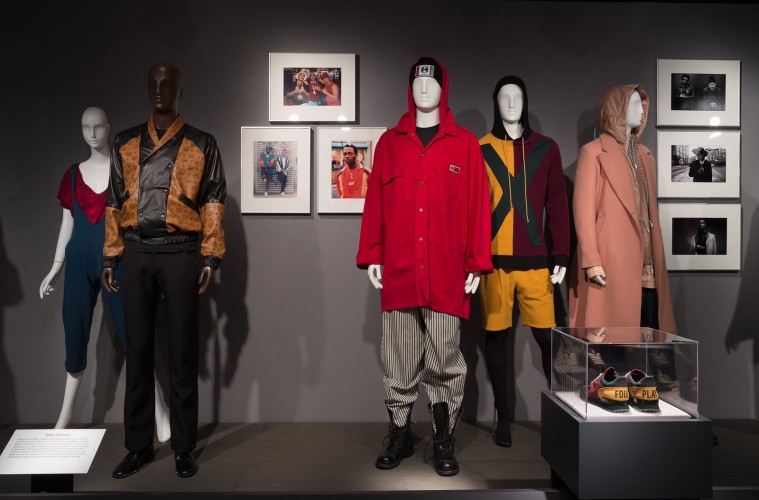Review by Chad Groom
There’s something to be said for mounting a presentation where the subject matter is based primarily on race. However, the “Black Fashion Designers” exhibit at The Museum at FIT (Fashion Institute of Technology) eschews that limitation by presenting a spirited and painstakingly-curated look at the arc of the Black designer- or rather, the designer of note who happens to be Black.
You are welcomed into the space by Andre Leon Talley via audio tour (and a colorful vignette of designers Patrick Kelly and Duro Olowu), and are immediately thrust into the world of eveningwear. One can’t help but marvel at the sartorial offerings of Ann Lowe and Zelda Wynn Valdez, which sit beside more recent pieces by British wunderkind Oswald Boateng and womenswear workerman Charles Harbison.
Of course, one couldn’t cover Black Designers of note and not offer a piece or two from Willi Smith, Stephen Burrows and Patrick Kelly; any fashion lover from any walk of life knows them. Where the exhibit excels is in showing lesser-known yet intrinsically important designers like Scott Barrie (who some say would have been bigger had Stephen Burrows not happened), and Patrick Robinson (who has worked for everyone from Armani to Anne Klein to Paco Rabanne), while introducing – or for some, re-introducing- modern unsung luminaries like Eric Gaskins, Andre Walker, Epperson and Edward Wilkerson. All of this while also being sure to include looks from the ubiquitous Olivier Rousteing, the envelope-pushing Cushnie et Ochs and the ever-ascending Laquan Smith.
Particularly enjoyable is the inclusion of a Menswear section in the exhibit. Often, when we talk about fashion in general, the menswear category is either glossed over or left out of the conversation altogether. Curators Ariele Elia and Elizabeth Way manage to give us an erudite – if not concise- overview of Black menswear designers, covering everyone from Sean John (whose 2008 fashion show set a new standard for how men’s clothing met at the intersection of urban and haute) to new kids on the block Grace Wales Bonner’s play on the fluidity of gender in fashion as well as the father-son design team of Joe and Charlie Casely-Hayford. Splendid!
The urban/streetwear category gives props to Cross Colours, and this is where we can see how far- and how sophisticated- this sector of fashion can be. One can see the distinction between how “Blackness” informed a line like Cross Colours, while the Pyer Moss sportswear line (which has often been mistakenly called “urban”) is designed by Kerby Jean-Raymond- who just happens to be Black.. Dapper Dan makes a well-deserved appearance in this section as well. The idea of activism and identity politics is also addressed in this section in an interesting way- which I’ll leave the visitor to see and interpret.

We are then treated to a video roundtable discussion on the state of Black models, moderated by Pulitzer Prize- winning fashion journalist Robin Givhan. A discussion with former models Bethann Hardison and Veronica Webb as well as new face Riley Montana plays on repeat and allows the visitor to sit and think about the trials and tribulations of being Black in an industry that most times doesn’t know what to do with that Blackness. At first, one wonders why this in included in the exhibit, but it becomes clear why; who wears and brings these extraordinary pieces to life- and thus sells them? Models, and in most cases Black models. Smart move by the curators, indeed. For historical sake, Beverly Johnson’s Vogue cover and Audrey Smaltz commentating the Ebony Fashion Fair show (created by fashion maven Eunice Johnson) are included, as well as references to the infamous fashion “Battle of Versaille”, which most agree ushered in the rise of the Black model to the main stage of the industry. Ophelia Devore, who started the first Black model agency, is also showcased.

At the conclusion, one is then treated to a Ruben Toledo illustration that is commentary on the cyclical nature of Fashion; deptly showing how hemlines, silhouettes, attitudes, cultural norms and the passage of time move the sartorial pendulum forward (and back).
Within the intimate footprint of one of the wings of The Museum at FIT, the “Black Fashion Designers” presentation gently threads the needle of the journey taken by more than a few designers of color; it leads us from Arthur McGee to Hood By Air to Xuly Bet- without leaving us with the feeling of being overwhelmed by fashion history.
The Museum at FIT will also host a Symposium on Black Fashion Designers, February 6, 2017. To register/RSVP, go to fitnyc.edu/museum or call212.217.4585


